After doing some paintwork in the house, you can find your bathroom smells like paint thinner most of the time. But it’s very irritating when you feel something uncommon in the bathroom, especially the odor.
It’s because the ventilation system in the bathroom is definitely at fault. When the vent pipe or window gets blocked, any odor or smell fails to go out from the inside. Primarily, you need to break the unwanted deposits in the vents to make the bathroom condition normal again.
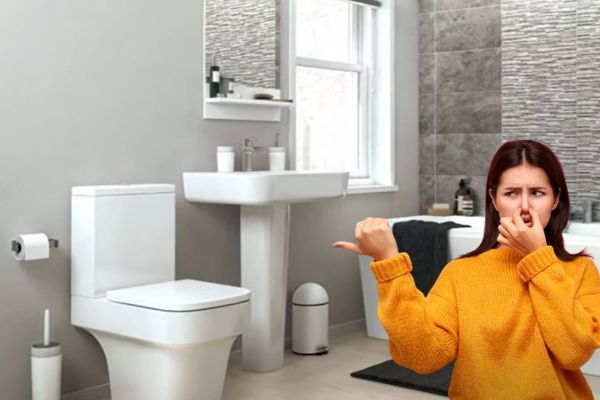
Apart, there are some other temporary solutions you can find on the market. But it’s better to go for the permanent measures. Thus, let’s discuss what you can do to eliminate the toxic smell from the bathroom.
Table of Contents
Why Bathroom Smells Like Paint Thinner [Explained]
If you ask what are the key reasons for the acetone smell in the bathroom, we’d say there are not too many. Apparently, you need to figure out where the foul odor is coming from and why it’s not getting out of the residence.

Here are the primary 3 reasons and their solutions that you need to remember in case you’re also facing the same issue.
1. Bathroom Painted Recently
The smell of Paint thinner would last nearly a week on the walls if you have painted your bathroom very recently. Even if you don’t apply the thinner with the oil-based paint, the painted area can smell like acetone or nail polish.
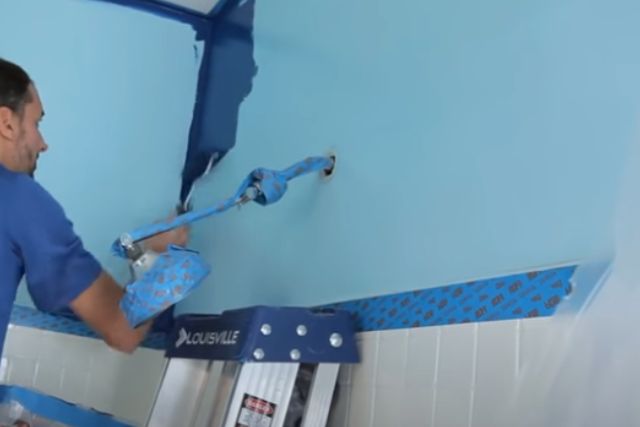
And surprisingly, the accessories of your bathroom like curtains, towels, carpets, and floor mats also get a strong paint odor when they stay near the freshly-painted walls and ceiling.
But sometimes, the smell gets caught in the bathroom even if you haven’t painted your bathroom walls. When you use a paint brand with less eco-friendly materials somewhere in your home, the whole area gets a strong odor that doesn’t evaporate so easily.
Solution:
It is necessary to follow the below tips if you want to fix the problem:
i) Evaporation
Firstly, open the ventilation windows of the bathroom. Now turn on the exhaust fan at full speed. If there’s no exhaust fan, take a table fan and put it in a way that the back of the fan faces the bathroom entrance.
Turn on the fan and let it suck the smelly air inside the bathroom when you’re not in there.
ii) Fabric Wash
Take the carpets and mats and sniff near them. If they also smell, put them under the sunlight in your backyard or terrace for a couple of days. You can also wash them with a strong detergent solvent for quick action.
[Note: If you opt to wash the carpets with detergent, try adding some edible soda to the solvent. Baking soda helps to make fabric and polymer smell neutral]
iii) Dehumidify
Additionally, you can take the help of the dehumidification process to keep the bathroom air fresh for a long time. There are bamboo charcoal bags found in the market that you can use for dehumidifying. Also, you can use an electric dehumidifier if you have a healthy budget.
[Note: Don’t try to use air freshener or naphthol products to cover up the bad smell. The air freshener can mix with the thinner odor to create something that’d make you suffocate in the bathroom.]
2. Clogged Ventilation System
The ventilation options’ failure is the biggest reason why there’s still a chemical smell in bathrooms even after the paint has gotten older.
Vent pipes are actually a gateway to release fumes and gases created in the bathroom. You can see a vent pipe on the roof of your home. The exact location of it also might be right at the top of your bathroom.

These vent pipes can be clogged due to aging, not cleaning regularly, the growth of small trees, etc.
Along with the vent pipe, there can be a ventilation window with an exhaust fan too. Most of the time, mold buildup, corrosion, and hard stuck can be why you can’t open or turn on the window and fan.
And for that, it takes time for all the irritating bad smells to go away from the bathroom.
Solution:
To inspect and clean out the ventilation system, here are some simple steps to follow:
i) Clearing The Vent Pipe
First of all, reach the vent pipe and open the mouth cap using a screwdriver. Then, tell someone standing in the bathroom to make some noise.
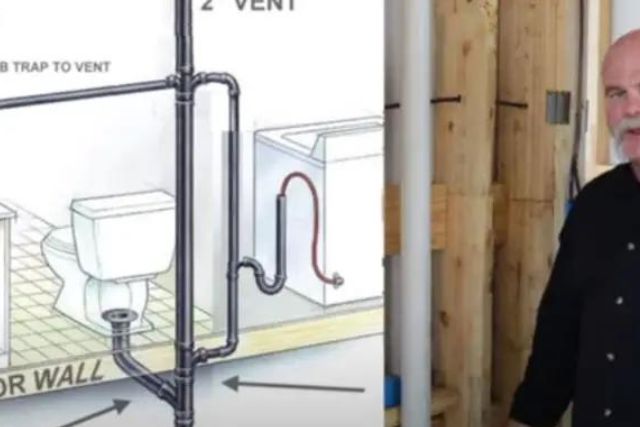
If you’re able to hear the noise clearly from the pipe, then there’s no need to do anything with the vent. But when the sound is unclear, you better start cleaning it.
Remove any bushes, birdhouses, and other stuff blocking the mouth of the vent. After that, Take a jet and spray cleaning solvent inside the pipe. Make sure the spray is hitting every part of the vent pipe.
ii) Making Windows And Fans Clean
Now, focus on the window and fan if they’re installed. Clean the frame of the window and the wings of the fan. You can also apply some metal grease to them to make their movement more flexible.
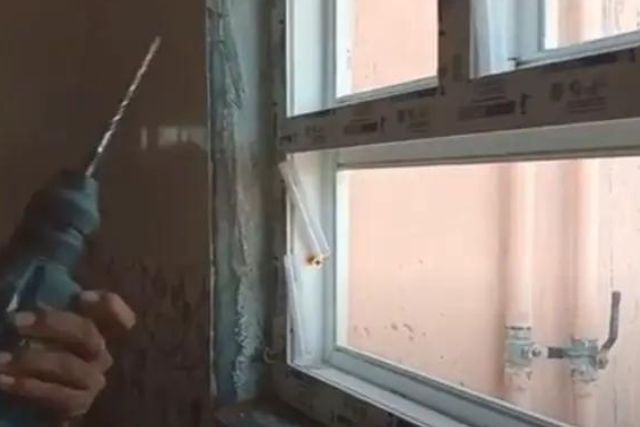
The most important part here is to check whether the frame of the window and fan is corroded or broken. You might have to replace the old frame with a new one made of plastic or aluminum.
3. A/C Failure
You’d be surprised to know that ACs and refrigerators can also release an odor almost like a paint thinner liquid. These appliances have an HVAC system infused in the main structure which can be the primary reason for the acetone smell.

The HVAC uses different chemicals and gases to manipulate temperature; acetone is one of them. Due to some leakage in the construction, these gases can come out into the home environment causing disturbing odors.
When you can smell acetone or nail polish remover odor around the house, along with the bathroom, you should consider the refrigerant system to be at fault. Otherwise, you need to consult and plumber to regain the usual bathroom condition.
Solution:
If you are looking for a solution, then you should follow the following tips:
i) Confirm The Source Of the Odor:
Turn on your AC and observe if you can detect the unusual odor. Follow the odor and try to identify the specific area or component of the AC system from which it is emanating. This will help you pinpoint the source of the problem.
ii) Safety First:
If you suspect a refrigerant leak, it’s important to prioritize safety. Refrigerants can be harmful when inhaled, so ensure proper ventilation by opening windows and doors while you inspect the AC system.
iii) Call A Professional Electrician Or HVAC Technician:
Refrigerant leaks and issues with the HVAC system should be handled by qualified professionals. Contact a licensed electrician or HVAC technician who specializes in AC systems to inspect and repair the problem.
iv) Professional Inspection And Repair:
The electrician or technician will thoroughly inspect your AC system to identify the source of the odor and any leaks. They will repair or replace any damaged components, fix refrigerant leaks, and ensure the system is functioning properly.
v) Regular Maintenance:
After the repairs, it’s essential to schedule regular maintenance for your AC system. Regular inspections and tune-ups can help prevent future issues and ensure optimal performance.
vi) Consider Professional Cleaning:
If the odor has permeated your home, you may want to consider professional cleaning services to help eliminate any lingering smells. They can use specialized techniques and equipment to clean the air ducts, filters, and other parts of your AC system to remove any traces of odor.
4. Plumbing Issue
If your bathroom smells like paint thinner, it can be concerning and potentially harmful to your health. The smell of paint thinner is often associated with the presence of volatile organic compounds (VOCs) or sewer gases in the plumbing system.
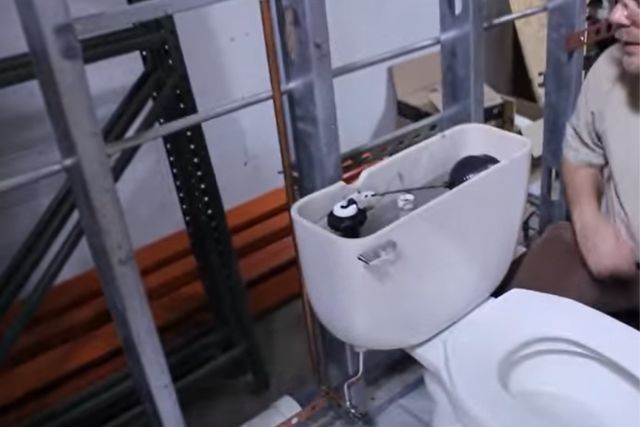
Here are some possible reasons for the unpleasant odor and steps you can take to address the issue:
i) Drain Issues:
One common reason for the paint’s thinner smell is an issue with the bathroom drain. If the water in the P-trap (a U-shaped pipe under the sink or tub) evaporates or leaks, it can allow sewer gases to escape into the bathroom, causing an unpleasant smell.
ii) Plumbing Leaks:
A hidden plumbing leak, such as a crack in the pipes, could be allowing sewer gases or chemical odors to escape into the bathroom.
iii) Sewer Line Issues:
In some cases, the smell might not originate from within the bathroom but could be a result of a problem in the main sewer line.
Solution:
Fix the plumbing issues as follows:
i) Clean The Drain Line:
Run water in all the bathroom drains, including the sink, shower, and bathtub, to ensure that the P-traps are filled with water. This water barrier will block the sewer gases from entering the bathroom. If the P-trap is leaking, have it repaired or replaced by a professional plumber?
ii) Repair leaks:
Inspect the visible plumbing connections under the sink and around the toilet for any leaks or signs of water damage. If you suspect a hidden leak, it’s best to consult a professional plumber to conduct a thorough inspection and make any necessary repairs.
iii) Inspect The Sewer Line:
If you have ruled out all other possibilities and the smell persists, contact a professional plumber to inspect the main sewer line and address any potential issues.
iv) Regular Maintenance:
Schedule regular plumbing inspections to identify and address any potential issues before they become major problems. A professional plumber can detect early signs of wax seal deterioration or vent blockages and take appropriate measures to prevent odors.
5. Use of Chemical Spills
Chemical spills can occur when containers are mishandled or knocked over. If you store chemicals or cleaning products in your bathroom, a spill could release fumes that produce a paint-thinner-like odor.
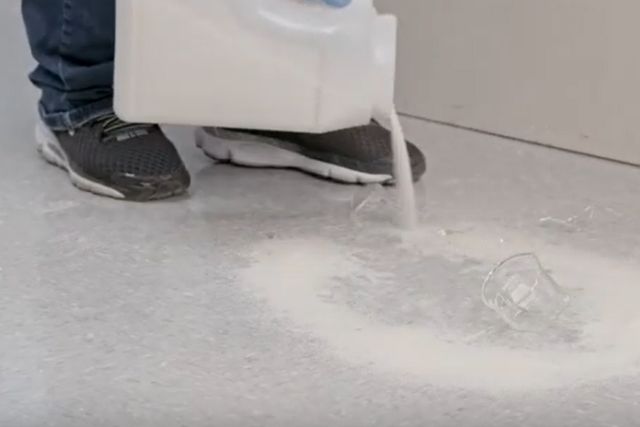
In fact, improperly sealed or damaged containers can leak chemicals, leading to a persistent smell in the bathroom. Sometimes, these odorous substances can evaporate and create a strong scent resembling paint thinner.
Solutions:
i) Clean Up Spills Immediately:
If you notice a chemical spill, it is essential to clean it up promptly and safely. Put on protective gloves and use absorbent materials, such as paper towels or rags, to soak up the spilled substance. Dispose of the soiled materials properly according to local regulations.
ii) Secure Containers Properly:
Ensure that all chemical containers in your bathroom are tightly sealed to prevent leaks. Check for any damaged containers and replace them if necessary. Consider storing chemicals in a dedicated, well-ventilated storage area outside of the bathroom to minimize the risk of spills or leaks.
iii) Proper Storage:
Store chemicals and cleaning products in a safe and secure manner. Keep them in well-sealed containers specifically designed for chemical storage. Ensure that the containers are labeled correctly to avoid any confusion.
iv) Handle with care:
When using or handling chemicals in your bathroom, follow the manufacturer’s instructions and exercise caution. Take necessary safety measures, such as wearing gloves and protective eyewear, to minimize the risk of spills or leaks.
v) Choose Safer Alternatives:
Consider using non-toxic or environmentally friendly cleaning products in your bathroom. These products are generally less likely to emit strong odors or pose health risks if accidentally spilled.
Warning:
Remember, chemical spills or leaks can be hazardous, so always prioritize your safety and follow appropriate guidelines when handling or cleaning up chemicals.
How To Get Rid Of Paint Thinner Smell From Bathroom?
To effectively get rid of the paint thinner smell from your bathroom, follow these steps:
i) Proper Ventilation:
Open windows and doors to allow fresh air to circulate in the bathroom. This will help in dissipating the odors. You can also use fans or exhaust fans to improve air circulation and expel the smelly air.
ii) Clean Surfaces:
Thoroughly clean all surfaces in the bathroom, including walls, floors, countertops, and fixtures. Use a mild detergent or a mixture of water and vinegar to remove any residual odors. Pay special attention to areas where the paint thinner may have come into contact.
iii) Use Baking Soda:
Sprinkle baking soda on carpets, rugs, or upholstery in the bathroom. Baking soda is known for its odor-absorbing properties. Let it sit for a few hours or overnight, then vacuum it up to remove the trapped odors.
iii) Charcoal Or Activated Charcoal Bags:
Place charcoal briquettes or activated charcoal bags in the bathroom. Charcoal is highly effective in absorbing and neutralizing odors. Leave them in the bathroom for a few days to help eliminate the paint-thinner smell.
iv) Air Fresheners:
Use air fresheners or odor-neutralizing sprays specifically designed for bathrooms. Look for products that eliminate odors rather than simply masking them. Be mindful of any sensitivities or allergies to certain fragrances and choose a scent that is not overpowering.
v) Vinegar Solution:
Fill a bowl with white vinegar and place it in the bathroom. Vinegar is known for its ability to absorb odors. Leave the bowl of vinegar overnight or for a few days to help neutralize the paint-thinner smell.
vi) Activated Carbon Filters:
Consider using activated carbon filters in your bathroom’s ventilation system or air purifiers. These filters are designed to remove odors and can be effective in eliminating the paint-thinner smell.
vi) Time And Patience:
Remember that the paint’s thinner smell will dissipate gradually over time. Keep the bathroom well-ventilated, clean regularly, and employ odor-absorbing techniques to accelerate the process.
But If the paint thinner smell persists or if you suspect an underlying issue, such as a plumbing problem, it is advisable to seek professional assistance. A professional plumber or odor remediation specialist can provide a thorough inspection and address any potential sources of the odor.
Warning: When working with paint thinner or any other strong chemicals, always ensure proper ventilation and follow safety guidelines to minimize odors and health risks.
What Does Paint Thinner Smell Like
The smell of paint thinner is almost like nail polish or wood burnish. It’s a pretty pungent aromatic solvent. Sometimes, low-quality paint thinner might smell like dissolved protein that can even make you puke.
Most importantly, the use of raw paint thinner can make the air in the room heavy and hard to inhale. People often feel dizzy or high when they enter a space fully covered with a thinner or acetone smell. The odor hits your nose hard and loosens your nerves for a while.
Is A Paint Thinner Smell Bad for Health
Yes, a paint thinner smell can be bad for health. It contains volatile organic compounds (VOCs) that can cause respiratory irritation, dizziness, and other health problems.
Suppose, you’re entering your bathroom, and while putting a step inside, you feel you’ve entered into a gas chamber where the air’s heavy and uncomfortable. Is such a situation good for anyone? Surely, you’d say no.
As we’ve said before, many commercial thinners contain a high amount of acetone. Along with that, there’s toluene. This stuff can cause oxidation stress at the primary level when you constantly inhale the thinner smell while breathing.
After some time, the inhalation of this smell can attack the lungs and cause lung inflammation. Because of this, you can suffer from cough, migraine, asthma, etc.
But the most dangerous thing is, thinner particles can go inside your body through the air and make your reproductive organs less active. So, getting in touch with thinner or its smell means slowly poisoning your body. That’s why you better take every necessary measure to eradicate the paint thinner odor.
How Much Paint Thinner Should You Use
As we can see, you need to use paint thinner with oil-based paints most of the time. So, you need to be careful about how much thinner you’re mixing with the paint. Because overuse of paint thinner makes the bathroom environment smelly and hard to stay in.
Let’s see a step-by-step guide to make sure you have the right amount of thinner mixed with your oil-based or acrylic paint.
1. Read The Paint Label
The first thing for you to do is read the instruction label on the paint can. The manufacturer would surely notify you of the elements of the product and the amount of pre-mixed thinner from the factory.
2. 4:1 is the Ideal Standard
These days, people mostly use sprayers to redecorate walls and ceilings. If you also opt to spray paint, then the ratio of paint and thinner should be 4:1 or below.
Overuse of the paint thinner causes the color to dampen and corrosion on the walls. And the main thing is, the extra thinner is disturbing stuff for your interior environment and your health.
3. Test the Paint
Before applying the paint with thinner mixed, you should test it on some other hard surface that you don’t need anymore. It6 is to ensure whether you’ve mixed the right amount of paint thinner or not. After making sure there’s no extra amount of thinner by the spray test, you can go for the paint job now.
Can You Paint Walls Without Using Paint Thinner
Yes, you can paint walls without using paint thinner. Paint thinners are not essential for the painting process. You can use regular paint directly or add a small amount of water to thin the paint if necessary for the desired consistency.
In fact, if you want to avoid using thinner paint, then you should also avoid using oil-based paints. You need to go for acrylic paint brands to paint your interior walls.
There are three major options left for you if you completely skip the oil-based paints.
- Cover your walls with tiles or decorating sheets
- Use factory-thinned oil-based paints
- Apply strong acrylic or water-based paints on walls after removing the old paint layer.
Some Essential Steps To Keep Your Bathroom Air Fresh
Now, you’ve understood that mainly ventilation failure can cause your bathroom to smell bad or weird. There are the necessary steps to be taken against it discussed above.
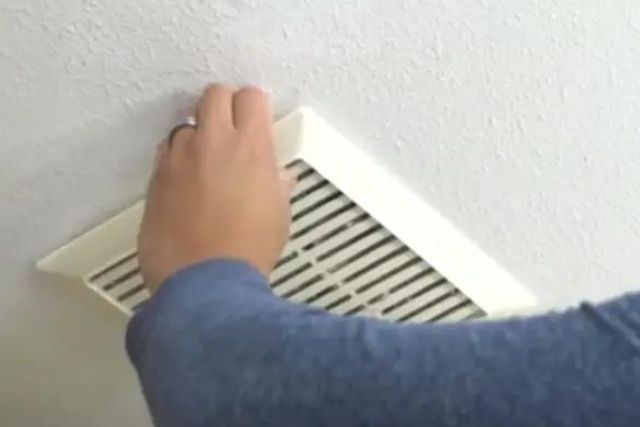
But apart from them, you should also add some essential things to the bathroom interior to make the bathroom environment more comfortable. Here are some facts that you can follow additionally with the countermeasures.
- If your bathroom doesn’t have an exhaust fan, buy one. You can buy the wall exhaust fan for easy mounting. But when you intend for something more reliable, you need to remodel the bathroom ceiling and purchase a modern exhaust vent with lights.
- Clean the vent pipes once every year. Don’t worry if you can’t do it yourself. You can hire experts for the jobs in an affordable price range.
- Don’t use too many air freshener sprays; it’s bad for your health. Instead, clean your bathroom 2 times a week and make sure the ventilation system is on.
FAQs:
What does it mean when you smell paint thinner?
If you smell paint thinner in your residence, it indicates two things; either some furniture or walls have got new paint coats, or there’s gas leakage in your house.
Why does my bathroom smell chemically?
Your bathroom can smell chemically because of the lack of ventilation, mold and bacteria buildup, sewer leakage, etc. Besides, some other things can happen outside that might change the air of your bathroom.
Does carbon monoxide smell like paint?
Carbon Monoxide has neither any specific color nor an exact smell. So, there’s no chance that carbon monoxide can smell like fresh paint.
Why does my bathroom smell like nail polish?
If you smell nail polish in your bathroom, it means there’s a refrigerant leakage somewhere near your bathroom. Otherwise, you should look for walls that still have wet paint coats over them.
Final Thoughts
Having a bathroom that smells like paint thinner might not seem very trouble for you. But in the end, inhaling odd fumes and gases can put your breathing organs at risk. There are many reports saying people have fainted due to suffocation or gas leakage in the bathroom.
Ultimately, you can’t neglect this issue at any cost. According to the National Library of Medicine, inhaling acetone for quite some time can negatively affect your kidneys and liver along with your lungs.
You better act quickly in this matter. We’ve already told you what you need to do. If you still feel you need to know something more, don’t hesitate to reach us anytime.
Note: You can also read our guide on why my shower sounds like a machine gun and how to fix it.


About James
James founded HomeUpgradeLab & was sharing his experiences to fix issues related to bathroom and toilet fixtures & fittings. Read to know more about James Hill & how he started this blog.